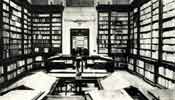1864-1903 : The “Villa Landau-Finaly”: a library of 60 000 books
In 1864, James de Rothschild, the owner of a bank in Turin, the first Italian capital, acquired the Villa Normanby. He was one of the financiers of the Risorgimento and one of the founders of the Italian Lira. However, he had little interest in the property, and sold it only two years later in 1866 to the director of his bank, Baron Horace de Landau. De Landau was a Hungarian citizen who represented the Rothschild bank in Turin and negotiated the large loans to the Piedmont government thus enabling the establishment of Italian unity in 1864. He led the life of a businessman and travelled frequently abroad. He continued to build extensions and modernise the building.
In 1872, he decided to retire so as to devote himself to his love of books and artistic works. In the hall on the second floor, now known as the Richelieu room, he developed a library of great richness and diversity, including illuminated manuscripts, early printed books, bibles, liturgical and religious books, first editions, rare editions, volumes signed by the author, musical scores and opera libretti, collections of poetry, medical treatises, books on surgery and mathematics, as well as miniatures and engravings, etc.
He constantly enriched his collection through acquisitions at the major sales in London and Paris. The library, which benefited from the services of a full-time librarian, a rare luxury at the time, now contains more than 60,000 volumes and is considered as one of the finest private libraries in Europe.
The Baron de Landau also bought hundreds of works of art – paintings, sculptures, tapestries, antique furniture and precious objects – which decorate the interior of the building, especially the Stendhal room. The collection was often mentioned in the contemporary press, and several literary works were inspired by the sumptuous receptions given at the Villa.

